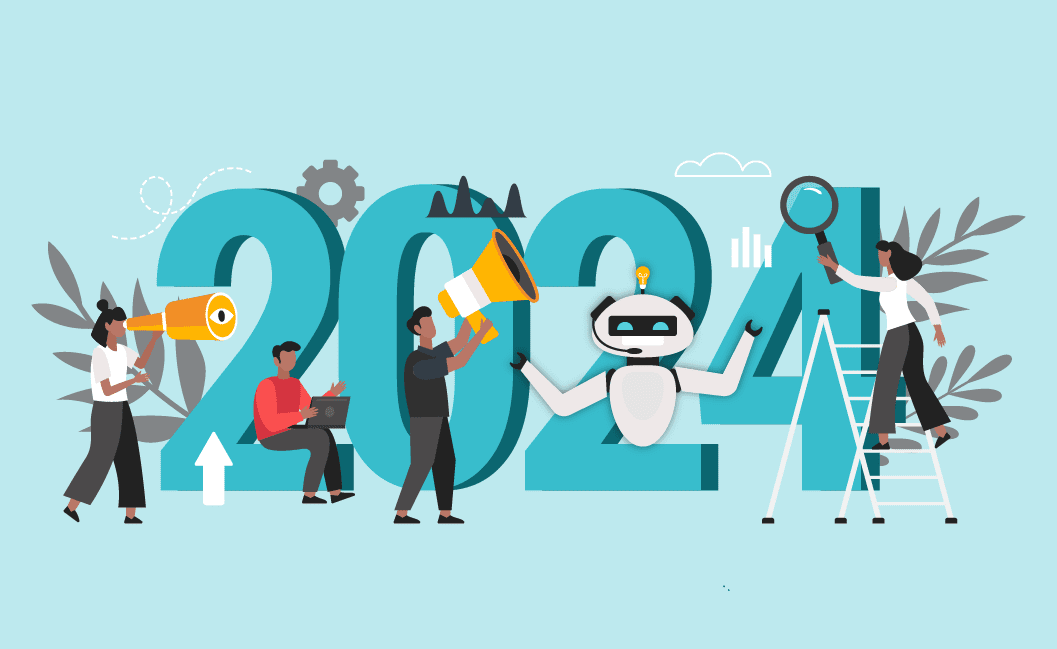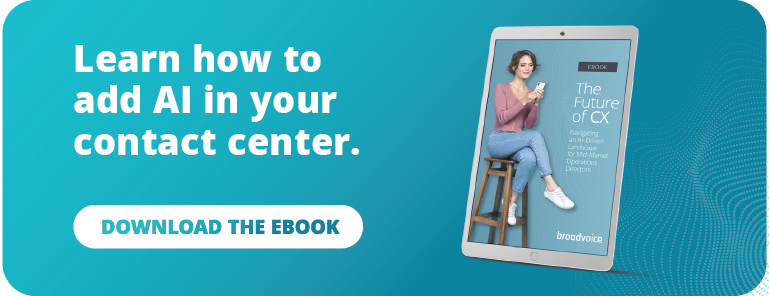Trends change almost daily. And, sometimes, it’s exhausting trying to keep up with the latest and greatest. After wearing what I thought was a very on-trend outfit, my niece informed me, “That’s soo not the look anymore.” Apparently, I missed the memo — ankle socks and skinny jeans aren’t cool anymore.
While not every trend is worth following, some are. In the contact center industry, failing to keep up with the latest trends can be detrimental.
One Qualtrics study found that $3.7 trillion in global sales are at risk due to bad customer experiences. Their recommendation? To reduce bad experiences, companies should better train and support their frontline employees.
That’s where contact center automation comes in.
Contact center automation trends and AI are the hottest topics in the executive suite right now. They can transform your mediocre experience into customer delight. What’s more, they can give agents the critical tools and support they need to thrive in their roles while removing the barriers of time and limited resources. And they can boost revenue, agent retention, and productivity.
Yeah, this trend might be worth paying attention to.
So, feel free to keep rocking your ankle socks (I will). But if you want to up your CX game, it’s time to get on board with these contact center automation trends.
Which Contact Center Automation Trends Are Worth the Investment
Contact center automation can transform a traditional contact center. It can take places plagued by slow processes and clunky tech and turn them into dynamic hubs of efficiency. By relying on tech to perform routine tasks — like call routing, data analysis, and customer inquiries — contact centers boost efficiency without needing human intervention. In the end, you get streamlined operations and enhanced customer experiences.
The right contact center automation leads to:
- Improved efficiency. Automation speeds up routine processes. For your center, this means customers spend less time waiting for help. And agents spend less time on tedious, repetitive tasks.
- Cost savings. Automation lets you handle more interactions with fewer agents, reducing costs. Plus, automated systems can operate 24/7 without added labor costs.
- Better customer service. Automation ensures faster response times and more accurate information. And with better customer insights, you can deliver more personalized interactions.
- Increased agent productivity. By automating mundane tasks, agents can focus on more complex, high-value interactions. This not only boosts productivity but also enhances job satisfaction.
- Greater data accuracy. Automated systems can capture, process, and analyze data faster than humans. And they’re more accurate. With AI-powered analytics and data mining, customer information remains up-to-date and reliable. This facilitates informed decision-making and better service delivery.
The best part? You can get these benefits (and more) by adopting these ten contact center automation trends.
Read our recent blog for essential stats to help build the business case for AI this year.
10 Contact Center Automation Trends to Make Your CX Unforgettable
1. Generative AI for Faster Service
Generative AI tools enable faster service and improved productivity. Using language learning models (LLM), AI systems can generate human-like responses during interactions.
When integrated with live chat or IVR, generative AI can interact with customers 24/7. AI can handle basic inquiries and reduce wait times. Agents can use generative AI to draft emails, take notes, summarize calls, and create scripts in seconds. The result? Improved efficiency.
2. Omnichannel Support for Greater Continuity
Contact center automation takes omnichannel support to the next level. Integrating AI across your communication channels allows you to deliver a seamless customer experience.
For example, you can use AI to track customer interactions across every communication channel. Then, you can gather info on sentiment, behavioral trends, and customer data during interactions. This gives agents access to detailed customer insights in real time. This extra intel empowers agents to deliver consistent, continuous, and more accurate support. I promise — your customers will thank you now that they don’t have to repeat themselves over and over (and over) again.
3. Predictive Analytics for Proactive Support
Predictive analytics help you get ahead of bad experiences. They use historical data and machine learning algorithms to anticipate customer needs and behaviors.
This info helps your agents address potential issues before they escalate. Predictive analytics can also share helpful resources with customers before they contact you or better prepare your team to handle an angry customer. This boosts CSAT and reduces the likelihood of churn.
4. Chatbots for Improved Self-Service Options
Problems can arise at any hour of the day. But that doesn’t mean you need agents on shift at 3 a.m. (Seriously, who would want that job?)
AI-powered chatbots give customers 24/7 support. You can expand your self-service options by using chatbots and virtual assistants to answer simple questions. These AI tools can assist customers with order tracking, basic troubleshooting, and more. With IVAs and chatbots, customers get faster, more convenient resolutions.
5. Automated Routing for Faster Resolutions
Last week, I called my insurance provider. Instead of getting help, I got the runaround on their IVR system. And I was still sent to the wrong department. Needless to say, it wasn’t a good customer service experience. Today’s customers want fast and direct resolutions. Contact center automation can help.
Automated routing systems analyze customer inquiries. They consider factors such as agent skills, availability, and customer history. Then, they direct customers to the most appropriate agent or department. This means customers get connected with the right resources right away. Better routing reduces wait times and increases the likelihood of first-contact resolution.
6. Workflow Automation for Improved Efficiency
According to Gartner, one in ten agent interactions will be automated by 2026. And for good reason. Workforce automation (WFA) streamlines internal processes by automating repetitive and manual tasks. You can reduce the time spent on tasks like data entry, ticket generation, and follow-up. With a lighter administrative burden on agents, you’ll increase efficiency and service quality. Get those time-consuming tasks out of the way and help agents focus on providing exceptional customer service.
Explore these essential tips for choosing the right WFA software for your team.
7. Agent Assist for Employee Empowerment
If you’ve ever de-escalated a frustrated customer, you know that the path forward and the right words aren’t always clear.
Agent assist tools provide real-time support to agents during customer interactions. These tools use AI to analyze conversations. Then, they suggest relevant responses, resources, and actions. A little extra help paves a clear path for your agents so they know what steps to take next. Agent assist tools enhance efficiency and confidence by giving agents access to information and guidance. This leads to more effective and satisfying customer interactions. It also relieves agent stress and improves employee engagement and satisfaction.
8. Customer Experience Analytics for Enhanced Personalization
Customers crave personalization. And customer experience analytics make it easy to personalize conversations. You can use AI to collect and analyze data from touchpoints across the customer journey. This gives you insights into customer behavior and preferences. Then, use this data to delight customers with personalized recommendations and tailored support. These personalized experiences foster stronger customer relationships and loyalty.
9. AI-Powered Quality Assurance for Greater Accuracy
Manual QA is costly, inefficient, and prone to errors. But that doesn’t mean you should throw in the towel on maintaining quality. AI-powered QA tools simplify the process of monitoring and evaluating customer interactions. These tools can analyze large volumes of interactions for compliance, sentiment, and performance metrics. Then, they can provide consistent feedback. Automated QA ensures higher accuracy, leading to better service quality.
10. Automated Workforce Management for Optimal Staffing
Optimize your staffing with automated WFM tools. These tools reduce the complexity of scheduling, forecasting, and performance tracking. This means you can ensure your contact center is always optimally staffed. Then, you can forecast demand to align your workforce capacity and skills with customer needs. Workforce management (WFM) tools can also help you identify where to reduce costs. They can also track performance to find gaps, adjust training, and improve your CX.













